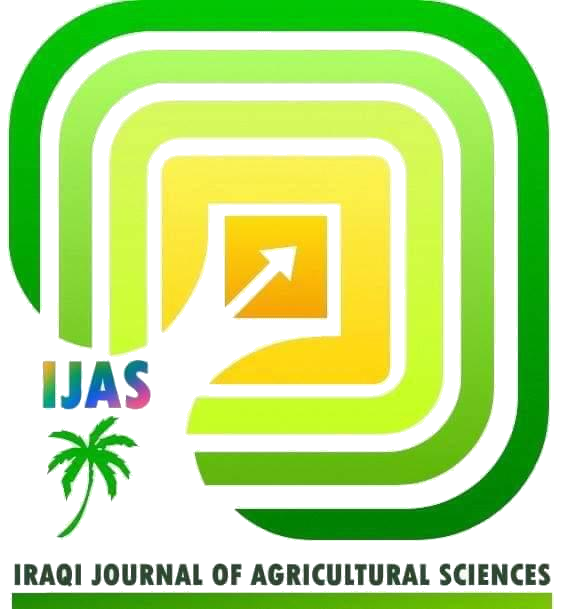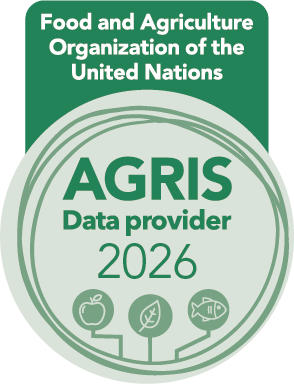¬ACTN3/ EXON-19 GENE POLYMORPHISM AND RELATIONSHIP WITH LOCAL HORSES PERFORMANCE IN IRAQ
DOI:
https://doi.org/10.36103/gbhmrk66Keywords:
genotype, body dimensions, philological traits, actn, horses.Abstract
This study was conducted to investigate the polymorphism of ACTN3/EXON-19 gene and their relationship the performance of local horses in Iraq. This study was carried out at the Iraqi Equestrian Club (15 km west from Baghdad city center) period during d from 1 February to 30 December 2022, to investigate the gene polymorphism of ACTN3 region EXON-19 and their relationship with performance of local horses in Iraq. Were found three variants (3 SNPs) in the ACTN3 gene - exon 19 and in different locations, namely rs1148960207, whose genotypes were CC, CT, and TT, as their distribution rates were significantly different (P≤0.05). The ratios of heterogeneity rs1144413495 with genotypes CC, TC, and TT were 34.21, 60.53, and 5.26% that differ significantly at (P≤0.01), with an allelic frequency of 0.64 and 0.36 for the two alleles C and T, respectively. The variant rs1148960207 had a significant (P≤0.05) effect on post-exercise breathing depth, speed rate and body length. Moreover a highly significant (P≤0.01) effect on heart girth and forefoot height for local horses. In conclusion ACTN3 gene has a distinct role in some physiological traits like the number and depth of respiration after exercise, rate of speed, and some body measurements, like body length, heart girth, and frontal height.
References
1. Abdullah, M. A. N., M. Ismail and E. M. Sari. 2021. Comparison of the reproductive performance of Gayo and Thoroughbred derivatives horses in Gayo Lues Regency. Advances in Biological Sciences Research, 20. Proceedings of the International Conference on Improving Tropical Animal Production for Food Security (ITAPS 2021), 159-162.
https://doi.org/10.2991/absr.k.220309.033.
2. Abed, A., T. A., Abdulkareem. . and W. A. Saleh. 2025. Effect of reproductive stages on some blood metabolites in the show and racehorse mares in Iraq. Iraqi Journal of Agricultural Sciences, 56 (Special Issue): 111-122. https://doi.org/10.36103/s2gw6m75
3. Abed, A. and T. A., Abdulkareem. 2025. Blood biomarkers of show and racing equine stallions in Iraq: A comparative study. Iraqi Journal of Agricultural Sciences, 56 (1): 347-357. https://doi.org/10.36103/g3ndj544
4. Ablondi, M., C., M., Dadousis, S., Vasini, S. Eriksson, A., Mikko, and A. Sabbioni 2020. Genetic diversity and signatures of selection in a native Italian horse breed based on SNP data. Animals (Basel). 10(6):1005. https://doi.org/10.3390/ani10061005
5. Ablondi, M., M.,Vasini, V., Beretti, P., Superchi and A., Sabbioni. 2018. Exploring genetic diversity in an Italian horse native breed to develop strategies for preservation and management. J Anim Breed Genet. 135(6):450–459. https://doi.org/10.1111/jbg.12357
6. Ablondi, M., A., Viklund, G., Lindgren, S., Eriksson, and S. Mikko. 2019. Signatures of selection in the genome of Swedish warmblood horses selected for sport performance. BMC Genom., 20, 717. https://doi.org/10.1186/s12864-019-6070-1
7. Adamu, L., N.M., Adzahan, R. Abdullah and B. Ahmad .2012. Effects of speed, heart rate, lactate and uric acid on the performance of arabian horses during a 120-km endurance race. IOSR J. Agric. and Vet. Sci., 1:1-4. https://doi. 10.9790/ 2380/010104.
8. ALani, A. and A. A. Yousif. 2023. Detection of Theileria equi in Baghdad racing horses using hematological and molecular assay. Iraqi J. Vet. Med., 47 (1), 52-59. https://doi.org/10.30539/ijvm.v47i1.1501.
9. Al-Jubori, S.M. and R.H. Senkal. 2023. Genetic diversity of Iraqi local cows and their comparison with imported cows using microsatellite markers. Iraqi Journal of Agricultural Sciences, 54 (6), 1529-1537.
https://doi.org/10.36103/ijas.v54i6.1852
10. Athmar, K.A., D.A., Kalef, and A.R., Fadl. 2015. The prevalence of the genus Eimeria in Draught and Al-Fourosia club horses of Baghdad Province. Iraqi J. Vet. Med., 39 (1): 70-74. https://doi. org/10.30539. iraqigvm. V39i1.199.
11. Beeson, S.K., J.R., Mickelson, and M.E., McCue . 2019. Exploration of fine-scale recombination rate variation in the domestic horse. Genome Res. 29(10):1744–1752. https://doi.org/10.1101/gr.243311.118
12. Bis-Wencel, H., L. Saba, and M. Kowaleczko. 2009. Effect of recreational and therapeutic use of horse on chosen hematological parameters of half-bred saddle horse. Annales Universitatis Mariae Curie Skłodowska. Sectio EE: Zootechnica, 27(2), 19-24.
13. Broos, S., L., Malisoux, and D., Theisen, 2016. Evidence for ACTN3 as a speed gene in isolated human muscle fibers. PLoS One, 11:e0150594. https://doi.org/10.1371/journal.
14. Burlikowska, K., M. Bogusławska-tryk, R. Szymeczko, and A. Piotrowska. 2015. Haematological and biochemical blood parameters in horses used for sport and recreation. Journal of Central European Agriculture, 16 (4), 370-382.
https://doi.org/10.5513/jcea.v16i4.3806
15. Capomaccio S, Ablondi M, Colombi D, Sartori C, Giontella A, Cappelli K, Mancin E, Asti V, Mantovani R, Sabbioni A, et al. 2023. Exploring the Italian equine gene pool via high-throughput genotyping. Front Genet. 14:1099896. https://doi:10.3389/fgene.2023.1099896
16. Criscione, A., S., Mastrangelo, E., D'Alessandro, S., Tumino, R., Di Gerlando, A., Zumbo, D., Marletta and S. Bordonaro S. 2022. Genome‐wide survey on three local horse populations with a focus on runs of homozygosity pattern. J. Anim. Breed. Genet. 139(5):540–555. https://doi:10.1111/jbg.12680.
17. Dominguez, R. and K.C., Holmes. 2011. Actin Structure and Function. Annu. Rev. Biophys., 9(40): 169–186.
https://doi.10.1146/annurev-biophys-042910-155359.
18. Duncan, D. B. 1955. Multiple Range and Multiple F Tests. Biometrics 11:1.
19. Gurgul, A., I., Jasielczuk and E., Semik-Gurgul. 2019. A genomewide scan for diversifying selection signatures in selected horse breeds, PLoS One, 14, (1), Article e0210751. https://doi.10.1371/journal.
20. Hamed, S.A.A. and A.K., Abbas. 2020. Detection and molecular study of Giardia Intestinalis in horses at Baghdad city, Iraq: Plant Archives, 20 (2): 8905-8911. https://doi. org/10.36103/ijas.v51i5.1153.
21. Hill, E.W., B.A., McGivney and D.E. MacHugh. 2023. Inbreeding depression and durability in the North American Thoroughbred horse. Anim Genet. 54(3):408–411. https://doi.org/10.1111/age.13309
22. Jungbluth, H., S., Treves, F., Zorzato, A., Sarkozy, J., Ochala, C. Sewry, and F. Muntoni. 2018. Congenital myopathies: disorders of excitation–contraction coupling and muscle contraction. Nature Reviews. Neurology, 14(3), 151–167. https://doi.10.1038/nrneurol.
23. Khalaf, A.I., N.N. Al-Anbari, and A.A., Al-Ani. 2022. Effect of ND5 gene on growth traits and milk production in Awssi sheep. Ind. J. Eco., 49 (20): 362-367. https://doi.10.21275/ART20194226
24. Mercier, Q., and A., Aftalion. 2020. Optimal speed in Thoroughbred horse racing. PLOS ONE, 15, e0235024. https://doi.org/10.1371/journal
25. Mukund, K. and S. Subramaniam, 2020. Skeletal muscle: A review of molecular structure and function, in health and disease. WIREs Mech. Dis., 12(1):1-46. https://doi.org/10.1002/wsbm.1462
26. Nagy, A., S.J. Dyson, and J.K., Murray. 2012. A veterinary review of endurance riding as an international competitive sport. The Vet. J., 194:288-93. https://doi.org/10.1016/j.tvjl.2012.06.022
27. Nidl, C., J. O. Merlino, E. A. Lopez, A. E. Monreal, G. Aquirre, J. A. Rangel and C. Venegas. 2017. Effect of age, gender and season on hematological parameters in quarter horses. J. Vet. Sci. Med. Diagn., 6 (2), 1-4.
https://doi.org/10.4172/2325-9590.1000224
28. Rieder, S., T., Sead, and M., Denis. 2010. "Mutations in the agouti (ASIP), the extension (MC1R), and the brown (TYRP1) loci and their association to coat color phenotypes in horses (Equus caballus)". Mam. Genome. 12 (6): 450–455. https://doi.org/10.1007/s003350020017
29. Sadeghi R, M, Moradi-Shahrbabak SRM, Ashtiani F, Schlamp EJ, Cosgrove and DF. Antczak 2019. Genetic diversity of Persian Arabian horses and their relationship to other native Iranian horse breeds. J Hered. 110(2):173–182. https://doi.org/10.1093/jhered/esy061
30. SAS. 2018. Statistical Analysis System, User's Guide. Statistical. Version 9.6th ed. SAS. Inst. Inc. Cary. N.C. USA.
31. Thomas, K.C., N.A., Hamiton, K.N., North, and P.J., Houweling. 2014. Sequence analysis of the equine ACTN3 gene in Australian horse breeds. Gene 538:88–93. https://doi.org/10.1016/j.gene.2014.01.014
32. Towfik, A.I., H.J., Hassan and B.J. Mohamed. 2017. Effect of running speeds on some markers of muscular tissues and synovial fluid of Iraqi Arabian Horses. Iraqi J. Vet. Med., 41 (2): 61-66. https://.org/10.30539/iraqijvm.v41i2.49.
33. Turki, W.Z. and N.N., Al-Anbari. 2018. Association of MSTN gene polymorphism with body dimensions and physiological performance in original Arabian horses. J. Res. in Ecology. 6 (1): 1581-1588.
34. Velie BD, KJ, Fegraeus M, Solé MK, Rosengren KH, Røed C-F, Ihler E, Strand and and G. Lindgren 2018. A genome-wide association study for harness racing success in the Norwegian-Swedish coldblooded trotter reveals genes for learning and energy metabolism. BMC Genet. 19(1):80. https://.doi.org/10.1186/s12863-018-0670-3
35. Wang, J., J., Meng, X., Wang, Y.,Zeng, L., Li, Y., Xin, X., Yao, and W., Liu. 2018. Analysis of equine ACTN3 gene polymorphisms in Yili horses. J Equine Vet Sci. 70: 101-106. https://doi.org/10.1016/j.jevs.2018.08.003
36. Warriach, H. M., M. A. Memon, N. Ahmad, S. Norman, A. Ghafar, and M. Arif. 2014. Reproductive performance of Arabian and Thoroughbred mares under subtropical conditions of Pakistan. Asian- Aust. J. Anim. Sci. 27:932-936. https://doi.org/10.5713%2Fajas.2013.13547.
37. Witkowska-Piłaszewicz, O., J. Grzędzicka, J. Seń, M. Czopowicz, M. Żmigrodzka , A. Winnicka , A. Cywińska , and C. Carter, 2021. Stress response after race and endurance training sessions and competitions in Arabian horses, Preventive Veterinary Medicine, 188, 105265. https:// https://10.1016/j.prevetmed.2021.105265.https://doi.org/10.1016/j.prevetmed.2021.1052 65.
Downloads
Published
Issue
Section
License
Copyright (c) 2025 IRAQI JOURNAL OF AGRICULTURAL SCIENCES

This work is licensed under a Creative Commons Attribution-NonCommercial 4.0 International License.

2.jpg)


